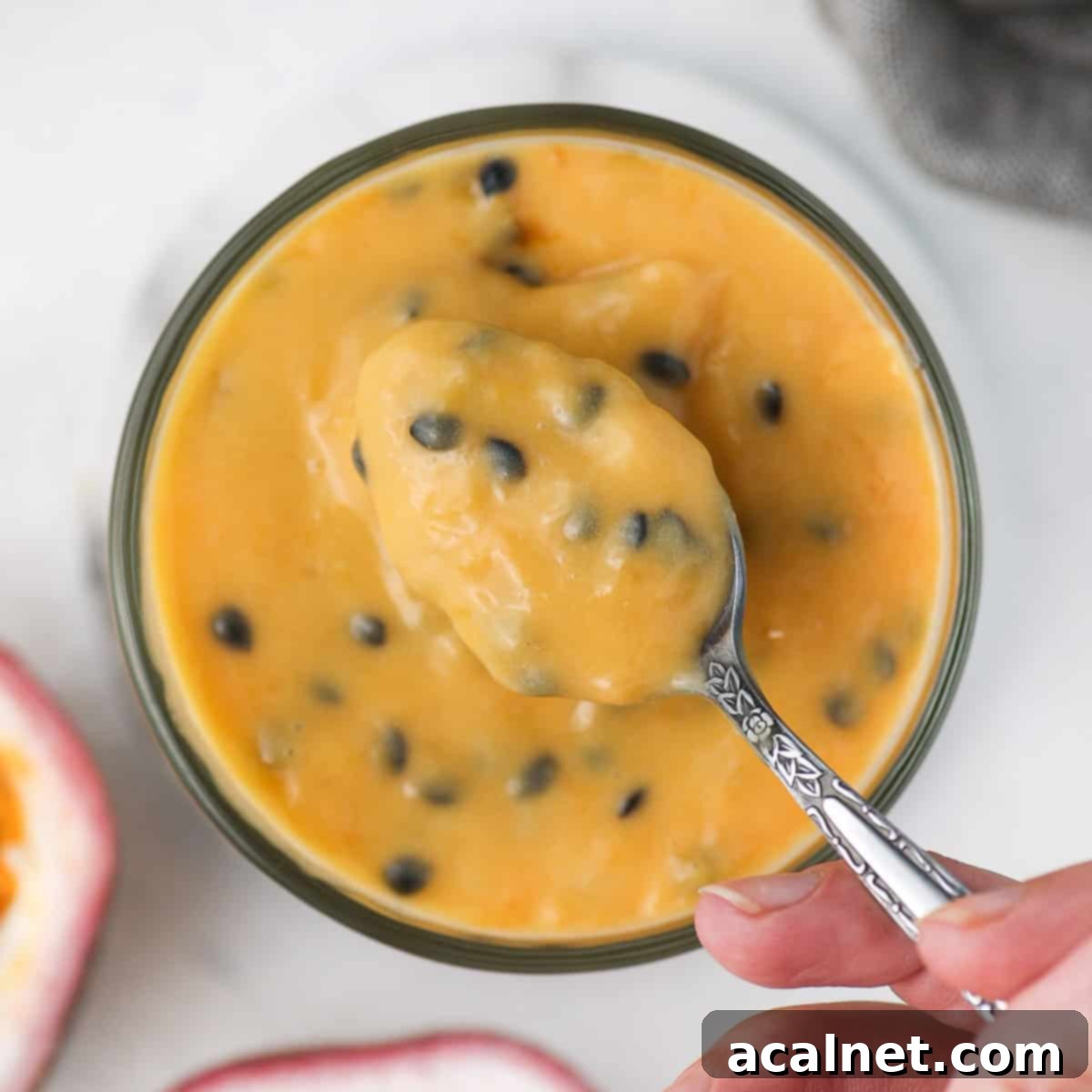Easy Homemade Passion Fruit Curd: A Bright, Zesty, 5-Ingredient Tropical Delight
Unleash a burst of tropical sunshine with this incredibly easy 5-ingredient Passion Fruit Curd recipe! Light, bright, and wonderfully fresh, it’s like capturing the essence of a vibrant summer day in every single spoonful. This versatile curd is an absolute game-changer for any dessert, perfect for elevating everything from simple scones and fluffy pancakes to elegant cheesecakes, pavlovas, and even as a luxurious cake filling or a delightful topping for ice cream and yogurt.
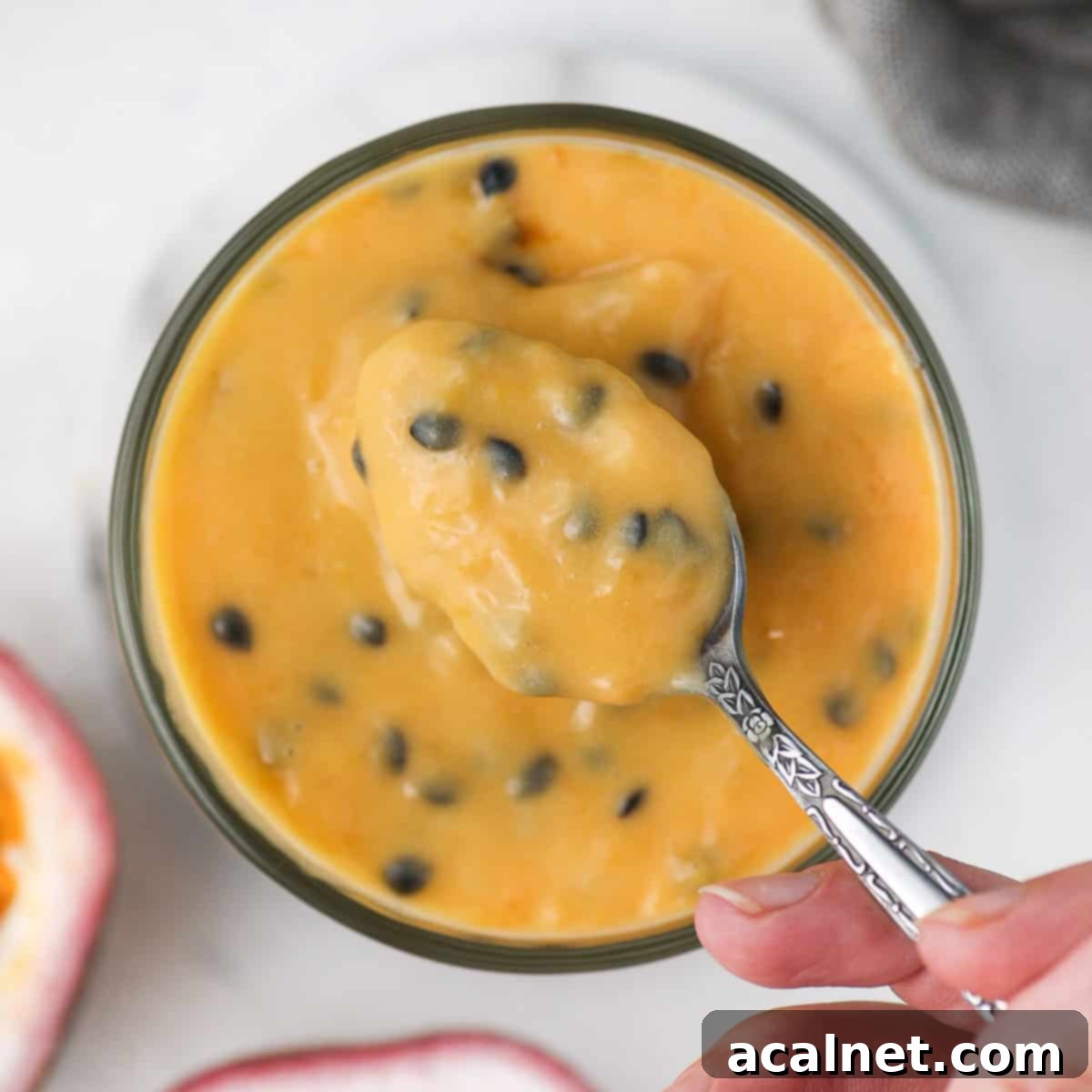
Why You’ll Adore This Passion Fruit Curd Recipe
While lemon curd often takes center stage, the world of fruit curds extends far beyond! Using exotic fruits like passion fruit is an incredible way to introduce new dimensions of flavor, creating curds that are not only bursting with vibrant taste but also stunning color. This homemade passion fruit curd stands out for its unique blend of sweetness and tang, perfectly complemented by a delightful textural contrast.
Passion fruit is truly a marvel. Its pulp offers a captivating duality – intensely sweet notes intermingle with a sharp, refreshing tang. But what truly sets it apart are its distinctive, edible black seeds. These tiny treasures provide a super fun crunch that adds an exciting element to the otherwise smooth and creamy curd. While you *could* strain them out, we highly recommend keeping them in for that signature passion fruit experience!
This recipe is designed for simplicity and speed, requiring only 5 basic ingredients and about 20 minutes of active cooking time. It’s an incredibly easy and rewarding project for any home baker, whether you’re a seasoned pro or just starting your culinary journey. If you’re fortunate enough to have a passion fruit vine overflowing with fresh fruit, this curd, much like our Passion Fruit Coulis and Passion Fruit Ice Cream, is a fantastic way to utilize your bountiful harvest and capture its fresh, vibrant taste.
Explore More Delicious Curd Recipes:
- Tangy Lemon Curd
- Bright Orange Curd
- Sweet Mango Curd
- Comforting Apple Curd
- Zesty Raspberry Curd
The 5 Essential Ingredients for Perfect Passion Fruit Curd
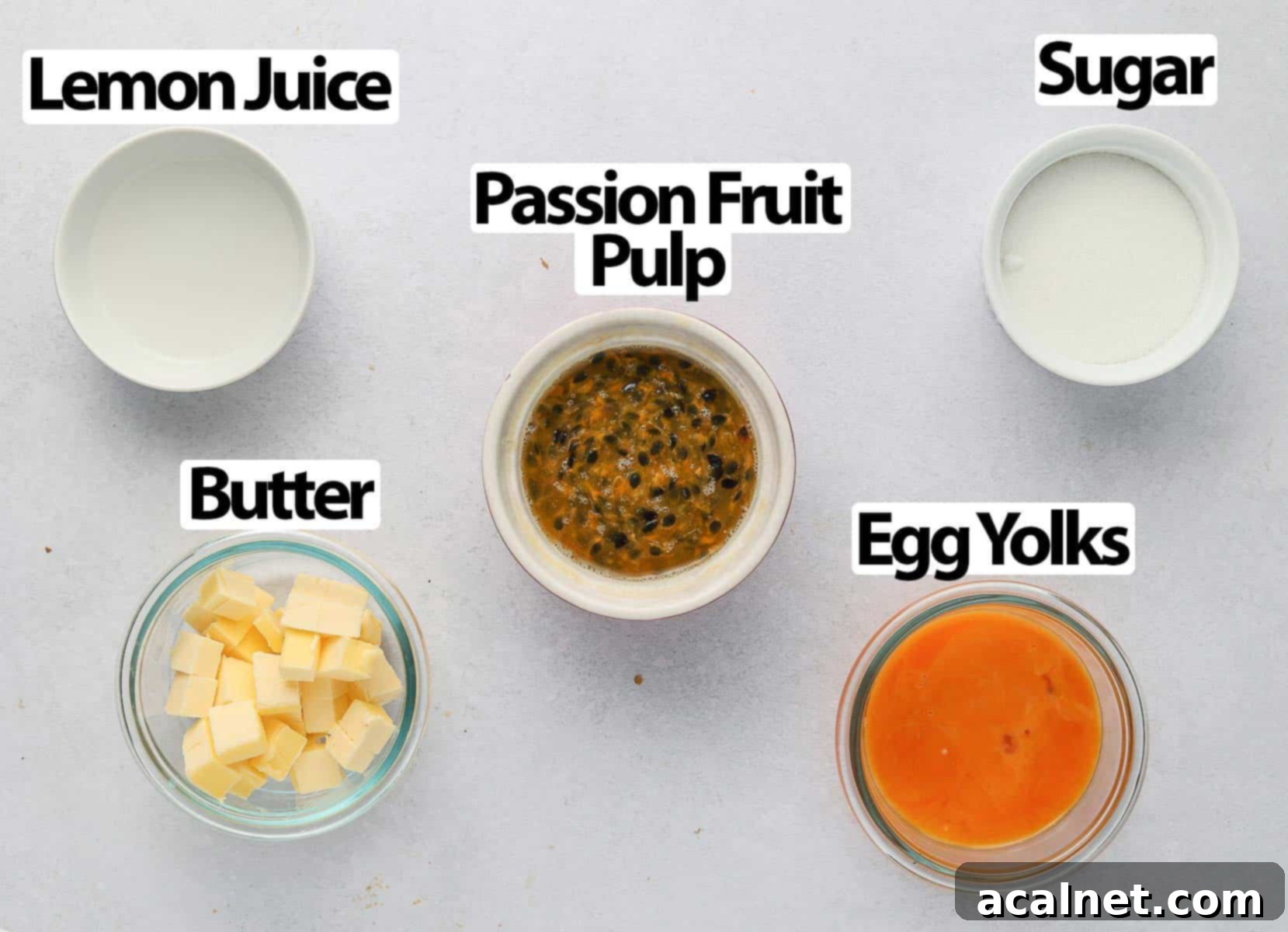
This deceptively simple curd recipe relies on just 5 fundamental ingredients to achieve its incredible flavor and texture. For exact quantities, please refer to the detailed recipe card below.
- Passion Fruit Pulp: This is the star of our show! You’ll need the pulp, which includes both the juicy flesh, the liquid, and the signature crunchy black seeds found inside fresh passion fruits. If fresh passion fruit isn’t readily available, high-quality frozen passion fruit pulp (thawed before use) is an excellent alternative, provided it’s 100% pure passion fruit with no added sugars or preservatives. For those considering canned passion fruit, please see our FAQs section below for important considerations regarding sugar content and preparation.
- Sugar: Granulated sugar, such as Caster Sugar or fine White Granulated Sugar, is ideal. Sugar not only provides sweetness to balance the tartness of the passion fruit but also contributes to the curd’s smooth texture and acts as a natural preservative. For a sugar-free alternative, natural sweeteners like honey or maple syrup can be used, though they may slightly alter the final flavor and consistency. Taste and adjust as needed.
- Lemon Juice: While optional, a touch of fresh lemon juice is highly recommended. It enhances the natural tanginess of the passion fruit and helps to brighten the overall flavor profile, creating a perfectly balanced sweet and sour experience. You can omit it if your passion fruit is particularly tart, or if you prefer a sweeter curd.
- Egg Yolks: These are crucial for the curd’s rich, creamy texture, vibrant color, and its ability to thicken. Use egg yolks from medium-sized eggs, and ensure they are at room temperature for optimal emulsification. If you desire an extra-thick curd, feel free to add one additional egg yolk. Don’t discard the egg whites – they can be saved for meringues, pavlovas, or other delightful recipes!
- Unsalted Butter: Butter adds luxurious richness, smoothness, and a beautiful sheen to the finished curd. It’s important to use unsalted butter to control the overall saltiness of the recipe. Take your butter out of the fridge about 10-15 minutes before you start, and cut it into small cubes. This ensures it’s slightly softened, allowing it to melt and incorporate smoothly into the curd mixture without clumping.
A Quick Tip on Taste: Passion fruits can vary greatly in their natural sweetness and tartness. We highly recommend tasting your passion fruit pulp before beginning the recipe. If you find it to be particularly tangy, you might consider omitting the lemon juice or slightly increasing the quantity of sugar to achieve your preferred balance of flavors.
How to Thicken Passion Fruit Curd to Perfection
Once this passion fruit curd has been properly cooked and subsequently chilled, it will naturally thicken to a beautiful, spreadable consistency, much like a rich jam or spread. There’s usually no need for additional thickeners in this recipe to achieve a wonderful texture for most uses!
However, if you’re aiming for a super-thick curd – perhaps for a specific application like a sturdy cake filling that needs to hold its shape – you can easily enhance its viscosity. Simply whisk in about 1 tablespoon of cornstarch (cornflour) with the sugar and egg yolks before tempering them with the warm passion fruit mixture. Ensure the cornstarch is fully dissolved to prevent any lumps. This will give you a denser, more robust curd that sets even firmer, though it might slightly reduce the curd’s natural glossy finish.
Step-by-Step Guide: Crafting Your Own Passion Fruit Curd
Making homemade passion fruit curd is a straightforward and enjoyable process. Follow these detailed steps to achieve a perfectly smooth, rich, and flavorful curd every time.
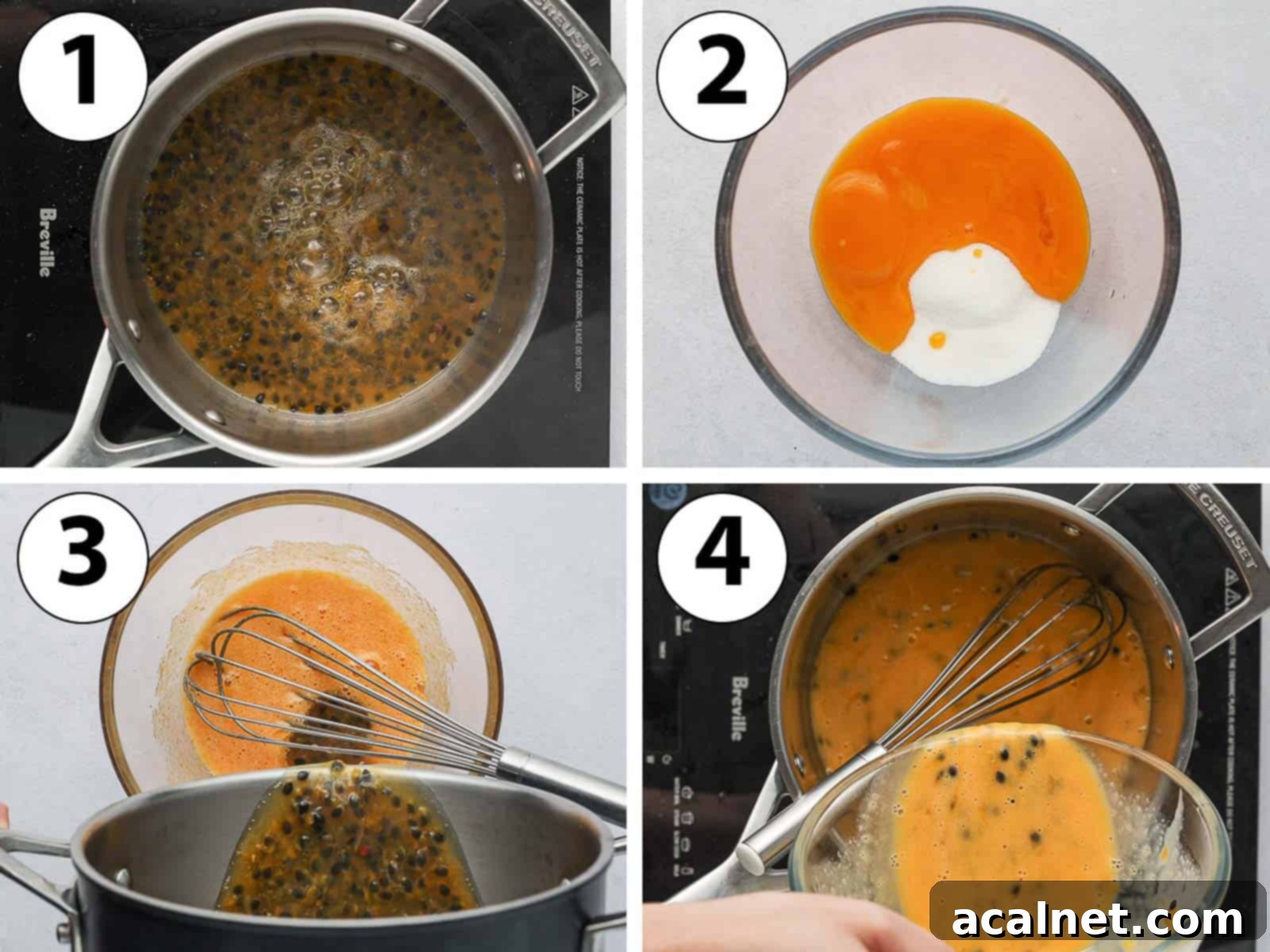
- Photo 1: Begin by preparing your fruit base. Combine the passion fruit pulp (including seeds, flesh, and juice) and fresh lemon juice in a small, heavy-bottomed saucepan. It’s crucial to use a non-reactive pan, such as stainless steel or glazed cast iron. Avoid aluminum pans, as the acidity of the fruit can react with the metal, imparting an undesirable metallic taste to your curd. Place the saucepan over medium-low heat and gently bring the mixture to a low simmer. This step helps to release the fruit’s flavors and prepares the liquid for tempering the eggs.
- Photo 2: Prepare your egg and sugar mixture. While the passion fruit mixture is heating, whisk together the egg yolks and granulated sugar in a separate heat-proof bowl. Whisk vigorously until the mixture becomes pale yellow and slightly creamy. This aeration helps to dissolve the sugar and prevents the yolks from cooking too quickly when the warm liquid is added.
- Photo 3: Temper the egg yolks. Once the passion fruit mixture reaches a gentle simmer, slowly pour about a third of the warm liquid into the egg yolk and sugar mixture, whisking continuously and vigorously. This crucial step, known as tempering, gradually raises the temperature of the egg yolks, preventing them from scrambling when they are fully combined with the hot fruit mixture. Continue to stir well until fully combined.
- Photo 4: Return to the saucepan. Pour the tempered egg and fruit mixture back into the saucepan. Return the pan to a very low heat setting on your stovetop. Keeping the heat low is key to preventing the eggs from overcooking and ensures a smooth, lump-free curd.
Note on Cooking Methods: For this recipe, we’re using the “direct heat” method, where the curd is cooked directly in a saucepan over low heat. This is generally quicker. An alternative is the “indirect heat” method, using a double-boiler, which offers more gentle, controlled cooking and reduces the risk of scorching, though it takes longer. Both methods are effective, but direct heat requires constant attention. (See FAQs section below for more details on these methods).
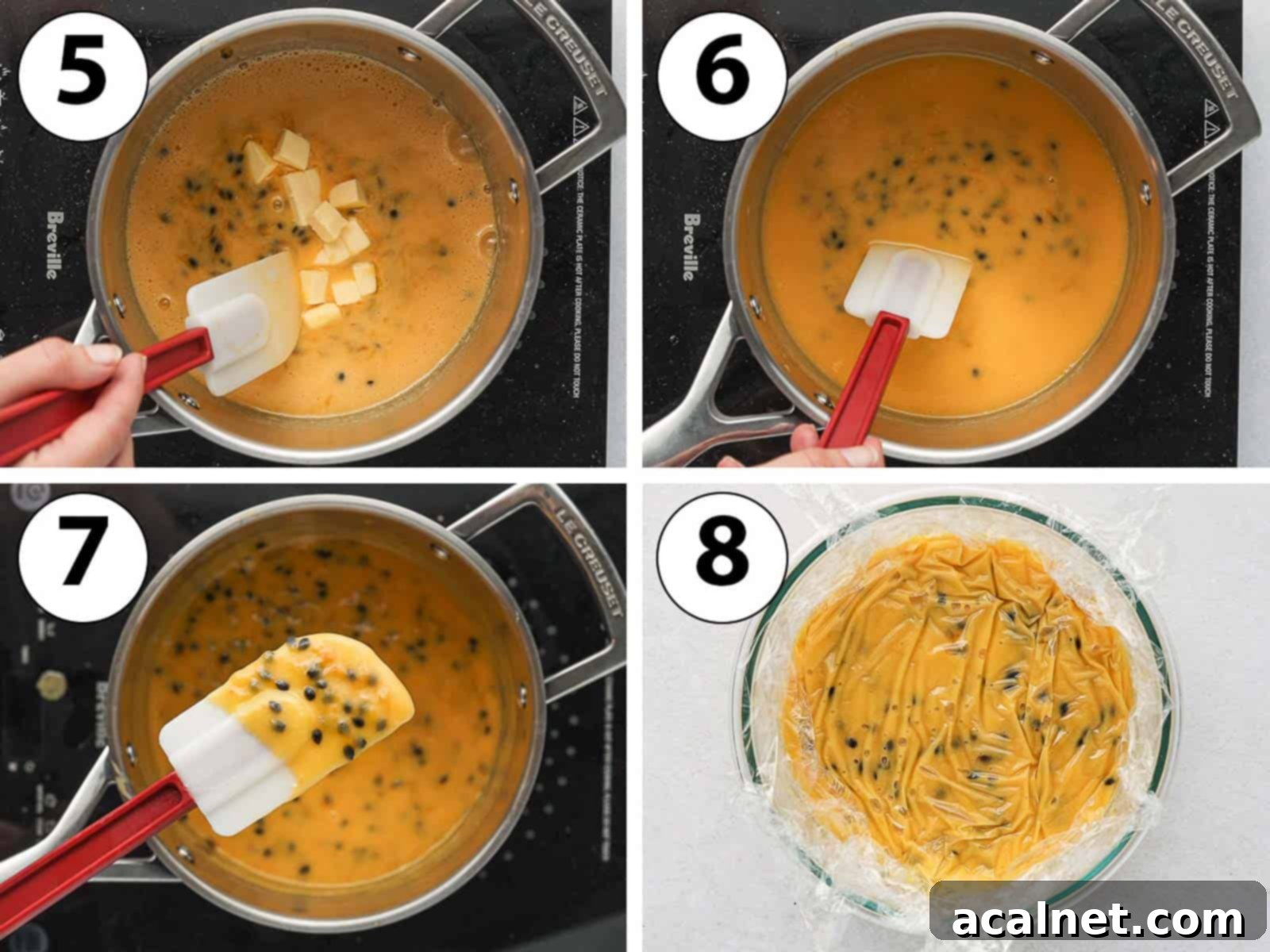
- Melt the sugar. Continue to cook the mixture on very low heat for 2 to 3 minutes, stirring constantly. This initial period allows the sugar to fully dissolve into the liquid before the thickening process truly begins.
- Photo 5: Incorporate the butter. Begin adding the unsalted butter, a small cube at a time, to the mixture. Stir continuously after each addition until the butter is completely melted and smoothly incorporated before adding the next piece. This gradual addition ensures the butter emulsifies properly, contributing to a silky-smooth and glossy curd.
- Photo 6: Cook until thickened. Continue to cook the curd over a very low heat, stirring continuously with a whisk or rubber spatula for approximately 10 to 15 minutes. The exact cooking time can vary depending on your heat source and the size of your saucepan. The goal is to gently thicken the mixture without boiling it, which could scramble the eggs.
- Photo 7: Check for doneness. The curd is ready when it has thickened nicely to a custard-like consistency. It should lightly coat the back of a spoon or spatula without being too runny. Remember, the curd will continue to thicken significantly as it cools and sets in the fridge.
- Chill and set. Once cooked, immediately transfer the hot curd into a clean bowl. Cover the surface of the curd directly with plastic wrap (ensure the wrap touches the curd’s surface). This prevents a “skin” from forming as it cools. Place the bowl in the fridge to chill and set for a minimum of 2 hours, or preferably overnight, for the best texture. Once chilled, you can keep it in the bowl or transfer it to a sterilized jar for storage.
Knowing When Your Passion Fruit Curd is Perfectly Cooked
Achieving the perfect consistency for fruit curd is essential, and there are two reliable methods to determine when your passion fruit curd is properly cooked and ready to be chilled:
- Temperature Check (Kitchen Thermometer Method): For the most precise result, use a reliable kitchen thermometer. The curd should reach an internal temperature of approximately 82°C (180°F). At this temperature, the egg yolks have cooked sufficiently to thicken the curd and create a stable emulsion, ensuring both safety and optimal texture. Continuously stir while monitoring the temperature to prevent scorching.
- Spoon Test (Visual Method): If you don’t have a thermometer, the “spoon test” is an excellent visual indicator. Dip the back of a spoon or a rubber spatula into the simmering curd, ensuring it’s well coated. Carefully draw a clear line across the back of the spoon with your finger (be extremely cautious, as it will be hot!). If the line remains clear and the curd doesn’t immediately run back into the gap, your curd is ready. If the curd is still too liquid and fills the gap quickly, it needs a few more minutes of gentle cooking and stirring.
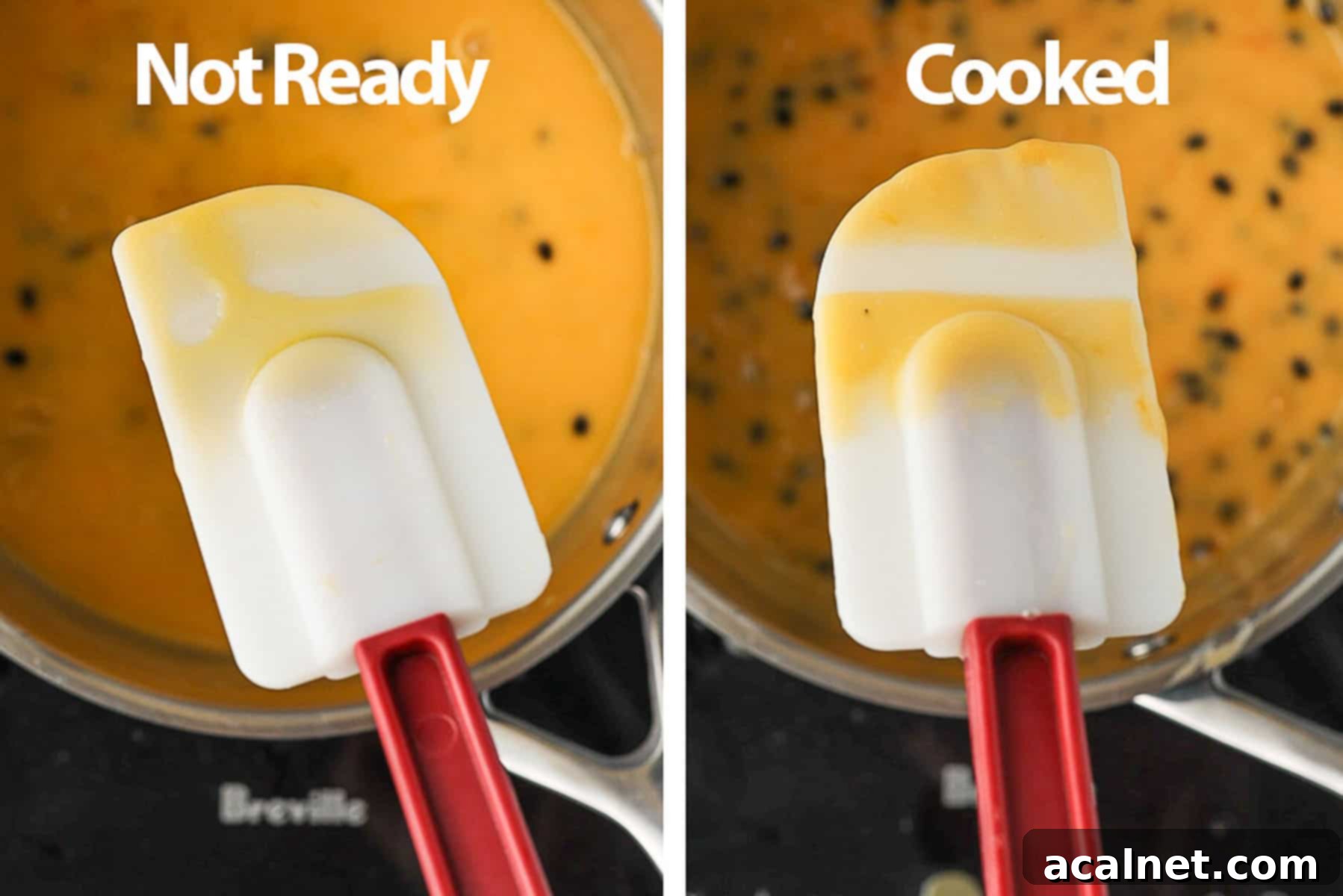
Delicious Ways to Enjoy Your Homemade Passion Fruit Curd
Once you’ve made a batch of this glorious passion fruit curd, the possibilities for how to enjoy it are virtually endless! Its bright, tangy-sweet flavor profile makes it an incredibly versatile ingredient and topping. Here are just a few ideas to get your culinary creativity flowing:
- Classic Spreads: The simplest pleasure is spreading it generously over warm scones, freshly baked toast, or toasted bagels for a delightful breakfast or afternoon tea.
- Breakfast Boost: Elevate your morning routine by dolloping it onto fluffy pancakes, crispy waffles, or rich brioche French toast. It’s also a fantastic swirl into oatmeal or yogurt.
- Elegant Desserts:
- Meringues and Pavlovas: Fill mini tart shells, meringue nests, or large pavlovas with passion fruit curd, then top with fresh berries and whipped cream for an impressive treat.
- Cakes and Cupcakes: Use it as a vibrant and tangy filling for layer cakes, cupcakes, or even as a flavorful topping. It pairs beautifully with vanilla, coconut, or chocolate.
- Cheesecakes and Tarts: Create a show-stopping passion fruit cheesecake or a luscious Passion Fruit Tart by using the curd as a top layer or a core filling.
- Mousses: Layer it with a creamy Passion Fruit Mousse for a dessert with contrasting textures and intense flavor.
- Small Bites: It makes a wonderful filling for delicate macarons or a delightful accompaniment to plain butter biscuits or shortbread cookies.
- Beyond Dessert: While primarily a sweet treat, its zesty nature can even complement certain savory dishes, like glazing roasted chicken for a tropical twist (use sparingly!).
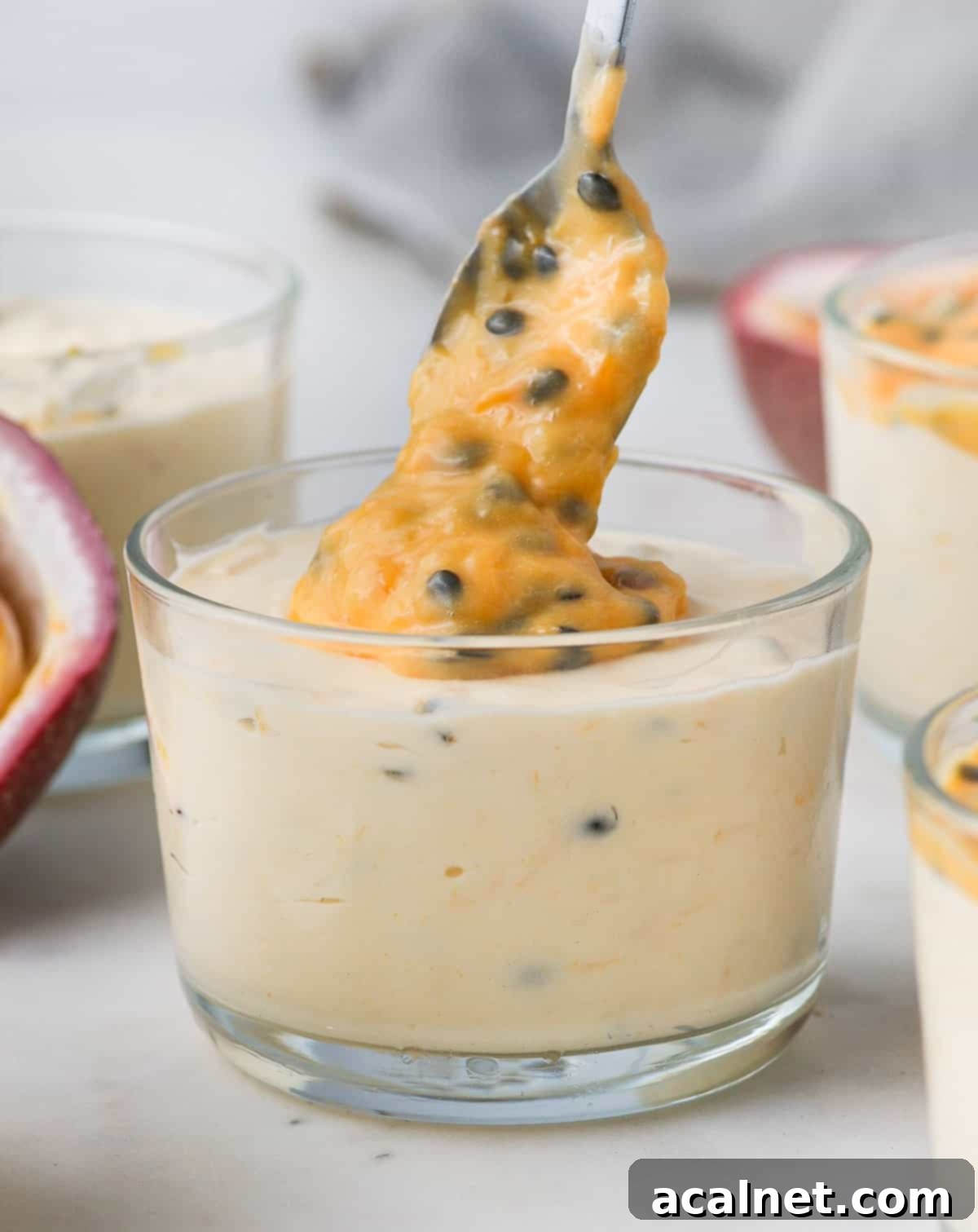
Passion Fruit Curd: Frequently Asked Questions
Both the “direct heat” and “indirect heat” methods are effective for making fruit curds, but they offer different advantages. The direct heat method involves cooking the curd directly in a saucepan over very low heat. It’s generally quicker and requires less equipment. However, it demands constant stirring and careful temperature control to prevent the eggs from curdling or the curd from scorching. The indirect heat method, using a heat-proof bowl set over a pot of simmering water (a double-boiler or “bain-marie”), cooks the curd more gently and slowly. This method significantly reduces the risk of overcooking the eggs or burning the curd, making it a more forgiving option, especially for beginners, although it takes a bit longer to thicken.
For the best flavor and texture, fresh passion fruit pulp is always recommended. It provides the most vibrant taste and the delightful crunch of natural seeds. If fresh passion fruit isn’t available, frozen passion fruit pulp (ensure it’s thawed completely before use) is an excellent substitute, as it usually retains a good flavor profile and often includes the seeds. Look for brands that contain 100% passion fruit with no added sugars or preservatives. If you opt for canned passion fruit, be very careful about its contents. Many canned versions come with added sugar or syrup. If using a sweetened canned pulp, you’ll need to significantly reduce the amount of sugar in our recipe. If it’s canned in syrup, it’s best to drain the syrup thoroughly to remove most of the excess liquid and sugar, then adjust the recipe’s sugar content accordingly. Always taste your passion fruit source first to gauge its sweetness and tartness!
Yes, it is possible to make a fruit curd without eggs, often referred to as a “vegan curd” or “fruit butter.” These versions typically rely on other thickening agents like cornstarch (cornflour), tapioca starch, arrowroot powder, or even agar-agar. While these egg-free curds can achieve a thick, spreadable consistency, they will have a different texture and flavor profile than traditional egg-yolk-based curds. Egg yolks contribute a unique richness, creamy mouthfeel, and vibrant color that alternative thickeners cannot fully replicate. While I haven’t personally developed an egg-free passion fruit curd recipe for this site, many excellent recipes exist if you’re looking for an alternative.
Absolutely, you can strain out the passion fruit seeds if you prefer a completely smooth curd. To do this, simply pass the cooked curd through a fine-mesh sieve or strainer after it has finished cooking and before chilling. While removing the seeds will result in a silkier texture, keep in mind that you’ll lose the characteristic “fun crunch” and visual appeal that the seeds provide. Many people find the seeds to be an integral part of the passion fruit curd experience, but it’s entirely a matter of personal preference!
To ensure a perfectly smooth and lump-free curd, there are a few key steps to follow. First, make sure your egg yolks and sugar are thoroughly whisked until light and creamy before tempering. Second, always temper your egg yolks by slowly streaming in the warm fruit juice while constantly whisking. This prevents the eggs from scrambling. Third, cook the curd over very low heat, stirring continuously with a whisk or rubber spatula, ensuring nothing sticks to the bottom. If, despite these precautions, you notice any small lumps of cooked egg, you can press the finished curd through a fine-mesh sieve immediately after cooking and before chilling. This will result in a beautifully smooth curd.
Tips & Troubleshooting for Perfect Passion Fruit Curd
Even with a simple recipe, things can sometimes go awry. Here are some common issues you might encounter when making passion fruit curd, along with easy solutions and preventative tips to ensure your curd turns out perfectly every time:
- The curd has a metallic taste: This unfortunate issue almost always occurs when the curd is cooked in an aluminum saucepan. Aluminum can react with the acidity of fruits like passion fruit, imparting a distinct metallic flavor. The solution: Always use a non-reactive pan such as stainless steel, glass, or glazed cast iron (like enameled cast iron) when making curds.
- The curd is too liquid/not thickening: Patience is key when making curd! Because we cook it over very low heat to prevent the eggs from scrambling, the thickening process can take some time. The solution: Keep whisking gently and consistently. It often takes the full 10-15 minutes, sometimes a little longer, to reach the correct consistency. Remember that the curd will also continue to thicken and firm up considerably as it chills in the fridge. If, after 15-20 minutes, it shows no sign of thickening and your egg yolks were on the smaller side, you can whisk in about 1 tablespoon of cornstarch (mixed with a little cold water to form a slurry first) into the curd and continue cooking for another few minutes until it thickens.
- The curd is too thick: If your curd becomes excessively thick, it’s usually a sign of overcooking or perhaps using too many egg yolks. The solution: You can try to thin it out slightly by whisking in a small amount of extra passion fruit juice (or even a tiny bit of hot water or melted butter if you don’t have extra juice). Do this gradually, adding just a teaspoon at a time, until you reach your desired consistency.
- I have bits of cooked eggs in my curd: This is an indication that your heat was too high, or you stopped stirring, allowing the eggs to scramble. The curd should never come to a rolling boil. The solution: To prevent this, ensure you temper your eggs properly at the beginning, use very low heat throughout the cooking process, and stir continuously. If you do end up with small bits of cooked egg, you can pour the warm curd through a fine-mesh sieve or strainer. However, keep in mind that this will also remove the passion fruit seeds, if you intended to keep them.
Storing & Freezing Your Passion Fruit Curd
Proper storage is essential to maintain the freshness and quality of your homemade passion fruit curd. Here’s how to keep it at its best:
- Refrigeration: Passion fruit curd should always be stored in the fridge. The best way to store it is in an airtight container or a sealed jar. If using a bowl, ensure you cover the surface of the curd directly with plastic wrap before sealing the bowl. This prevents the formation of an undesirable “skin” on top and helps to keep it fresh. While it may technically last a bit longer, for optimal flavor, vibrant color, and the freshest taste, we recommend enjoying your passion fruit curd within one week of preparation.
- Freezing: Curds can technically be frozen, but I personally do not recommend it for passion fruit curd. The high water content in fruit curds, combined with the emulsified fats from the butter and eggs, can lead to an undesirable texture change upon thawing. Often, the curd becomes grainy, watery, or separates when frozen and then defrosted, losing its smooth and creamy consistency. For this reason, it’s best to enjoy it fresh or within its refrigerated shelf life.
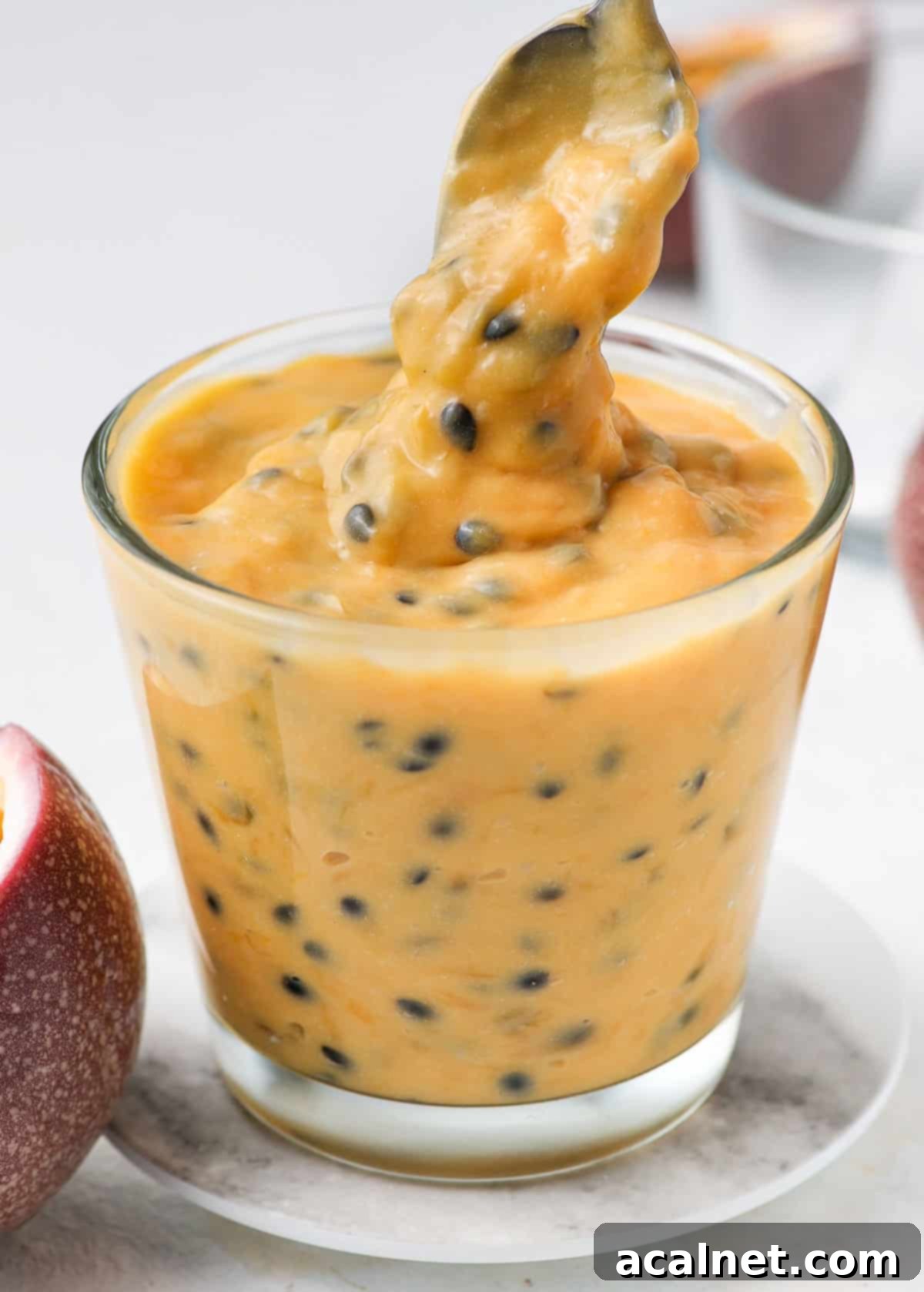
More Irresistible Fruit Sauces & Compotes
- Sweet & Tangy Stewed Rhubarb
- Easy 3-Ingredient Strawberry Compote and Silky Strawberry Coulis
- Simple Blueberry Compote and Smooth Blueberry Coulis
- Quick Raspberry Compote and Vibrant Raspberry Coulis
- Delicious Mixed Berry Compote
- Lush Mango Coulis
Made this recipe?
Let us know if you loved it by leaving a comment below, and don’t forget to tag us on Instagram @a.baking.journey with a photo of your beautiful creation!
Recipe Card: Easy 5-Ingredient Passion Fruit Curd

Passion Fruit Curd
Print Recipe
Ingredients
- 150 gr (5.5 oz) Passion Fruit Pulp, fresh or thawed frozen (see Note 1 in Notes section below)
- 30 ml (2 tablespoons) Lemon Juice
- 4 Egg Yolks, from medium-sized eggs, at room temperature
- 50 gr (1/4 cup) Caster Sugar
- 75 gr (5 tablespoons) Unsalted Butter, cut into small cubes, slightly softened
Instructions
- 1. Place the Passion Fruit Pulp and Lemon Juice in a small, heavy-bottomed, non-reactive saucepan (see Note 2). Turn the heat to medium-low and gently bring the mixture to a simmer.
- 2. While the fruit mixture is heating, whisk together the Egg Yolks and Caster Sugar in a separate heat-proof bowl until pale and creamy.
- 3. Slowly pour about a third of the warm passion fruit mixture over the egg/sugar mixture while continuously whisking to temper the eggs. Once combined, pour the entire mixture back into the saucepan and return to a very low heat (see Note 3).
- 4. Cook on very low heat for 2 to 3 minutes, stirring constantly, to allow the sugar to fully melt. Then, gradually add the softened butter, a little bit at a time, stirring continuously until each addition is fully melted and incorporated before adding more.
- 5. Continue to cook, stirring constantly with a whisk or rubber spatula, for about 10-15 minutes (or until the curd has visibly thickened and coats the back of a spoon – see Note 4 for tips on checking doneness). Ensure the mixture does not boil.
- 6. Once thickened, immediately transfer the curd into a clean bowl. Cover the surface directly with plastic wrap to prevent a skin from forming. Place in the fridge to chill and set for at least 2 hours, or until thoroughly cold and thick. Store in the bowl or transfer to a sterilized jar.
Would you like to save this recipe?
We’ll email this post to you, so you can come back to it later!
Notes
- You can use both fresh and frozen passion fruit pulp (thawed) for this recipe. This includes the seeds, liquid, and flesh. If using canned passion fruit, choose one without added sugar, or adjust the sugar quantity in the recipe significantly. If canned in syrup, drain thoroughly to remove excess liquid and sugar.
- Important: Do not use an aluminum saucepan, as the fruit’s acidity can react with it, causing a metallic taste. Opt for stainless steel, glass, or glazed cast iron.
- This recipe uses the “direct heat” method (cooking directly in the saucepan). This is quicker but requires constant stirring to prevent scorching. The “indirect heat” method (using a double-boiler) is gentler but takes longer. Both methods are effective (see FAQs for more details).
- There are two ways to check for doneness:
– Temperature: Use a kitchen thermometer; the curd should reach approximately 82°C (180°F).
– Spoon Test: Dip a spoon into the curd, draw a line on its back with your finger (careful, it’s hot!). If the line holds clear and the curd doesn’t run, it’s ready.
Nutrition (per serving)
